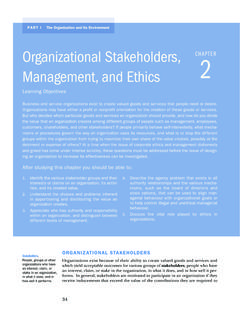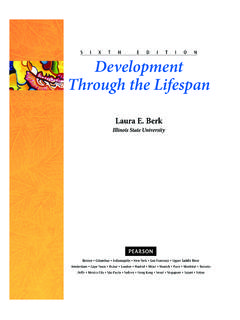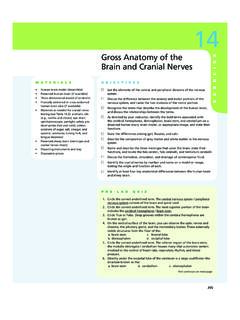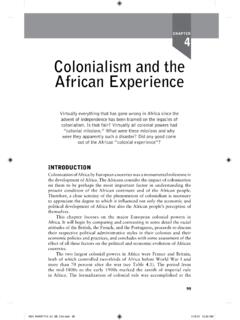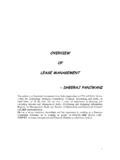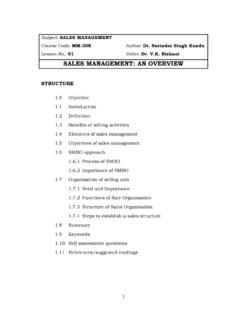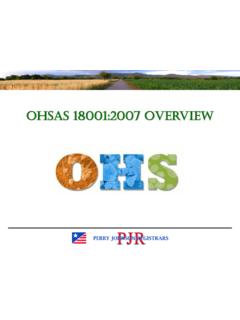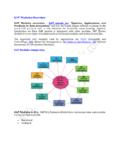Transcription of An Overview of Strategic Retail Management - Pearson
1 PART 1. An Overview of Strategic Retail Management Welcome to Retail Management : A Strategic Approach. We hope you find this book to be as informative and reader-friendly as possible. Please visit our Web site ( ) for interactive, useful, and up-to-date features that complement the text including chapter-by-chapter hot links, a study guide, and a whole lot more! In Part 1, we explore the field of retailing, the establishment and maintainance of relationships, and the basic principles of Strategic planning and the decisions made in owning or managing a Retail business. Chapter 1 describes retailing, shows why it should be studied, and examines its special characteristics. We note the value of Strategic planning and include a detailed review of Loblaw's. We then present the retailing concept, along with the total Retail experience, customer service, and relationship retailing. The focus and format of the text are detailed. Chapter 2 looks at the complexities of retailers' relationships with both customers and other channel members.
2 We examine value and the value chain, customer relationships and channel relationships, the differences in relationship-building between goods and serv- ice retailers, the impact of technology on retailing relationships, and the interplay between ethical performance and relationships in retailing. The chapter ends with Appendix 2A, on planning for the unique aspects of service retailing. Chapter 3 shows the usefulness of Strategic planning for all kinds of retailers. We focus on the planning process: situation analysis, objectives, identifying consumers, overall strategy, specific activities, control, and feedback. We also look at the controllable and uncontrollable parts of a Retail strategy. Strategic planning is shown as a series of inter- related steps that are continuously reviewed. At the end of the chapter, Appendix 3A dis- cusses the Strategic implications of international retailing. Chapter 1. An Introduction to Retailing A perfect example of a dream come true is the story of Sam Walton, the founder of Wal-Mart ( ).
3 From a single store, Wal-Mart has grown to become the world's largest retailer (in terms of revenues). As a store owner in Bentonville, Arkansas, Sam Walton had a simple strategy: to take his Retail stores to rural areas of the United States and then sell goods at the lowest prices around. Sam was convinced that a large discount format would work in rural communities. Walton's first discount store opened in 1962 and used such slogans as We sell for less and Satisfaction guaranteed, . two of the current hallmarks of the company. By the end of 1969, Wal-Mart had expanded to 31 locations. Within a year, Reprinted by permission. Wal-Mart became a public corporation and rapidly grew on the basis of additional discount stores, its supercentre format, and global expansion to more than 1,300 stores and clubs in nine countries, employing more than 300,000 associates. Canada has played a key role in this expansion, with the found- ing of Wal-Mart Canada in March of 1994.
4 Today, Wal-Mart Canada has more than 230 stores and five Sam's Clubs, employing more than 60,000 Canadians from coast to coast. Wal-Mart has become a true textbook example of how a retailer can maintain growth with- out losing sight of its original core values of low overhead, the use of innovative distribution systems, and customer orientation whereby employees swear to serve the customer. So help me, Sam. 1. The road hasn't been entirely smooth, though. Opposition to Wal-Mart's business practices has been growing, and the company has been criticized for its employment practices related to illegal immigrants. Residents of many communities have attempted to block Wal-Mart from opening new stores, and Wal-Mart has closed a store in Quebec that was threatening to unionize. Competing on price, and therefore on costs, has its own price. Time will tell how much consumers are willing to pay for everyday low prices. Chapter Objectives 1. To define retailing, consider it from various perspectives, demonstrate its impact, and note its special characteristics 2.
5 To introduce the concept of Strategic planning and apply it Chapter 1 | An Introduction to Retailing 3. 3. To show why the retailing concept is the foundation of a successful business, with an emphasis on the total Retail experience, customer service, and relationship retailing 4. To indicate the focus and format of the text Overview Retailing encompasses the business activities involved in selling goods and services to con- sumers for their personal, family, or household use. While retailing can be defined as in- cluding every sale to the final consumer (ranging from cars to apparel to meals at restaurants), we normally focus on those businesses that sell merchandise generally without transforma- tion, while rendering services incidental to the sale of merchandise. 2. Retailing today is at an interesting crossroads. On the one hand, Retail sales are at their high- est point in history. Wal-Mart is now the leading company in the world in terms of sales.
6 Ahead of ExxonMobil, General Motors, and other manufacturing giants. New technologies are improving Retail productivity. There are lots of opportunities to start a new Retail business or work for an existing one and to become a franchisee. Global retailing possibilities abound. On the other hand, retailers face numerous challenges. Many consumers are bored with shop- ping or do not have much time for it. Some locales have too many stores, and retailers often spur one another into frequent price cutting (and low profit margins). Customer service expectations are high at a time when more retailers offer self-service and automated systems. At the same time, many retailers remain unsure about what to do with the Web; they are still grappling with the emphasis to place on image enhancement, customer information and feed- back, and sales transactions. These are the issues that retailers must resolve: How can we best serve our customers while Visit Krispy Kreme earning a fair profit?
7 How can we stand out in a highly competitive environment where con- ( ) and see what drives what was one of sumers have so many choices? How can we grow our business while retaining a core of the world's hot retailers. loyal customers? Our point of view: Retail decision makers can best address these questions by fully under- standing and applying the basic principles of retailing in a well-structured, systematic, and focused Retail strategy. That is the philosophy behind Retail Management : A. Strategic Approach. Can retailers flourish in today's tough marketplace? You bet! Just look at your favourite restaurant, gift shop, and food store. Look at the growth of Shoppers Drug Mart/Pharma Prix, Loblaws, or such iconic examples as Canadian Tire or Tim Hortons. Is it easy? No. Look at the experience in early 2005 of Krispy Kreme, which was at that time closing stores in Ontario and facing lawsuits from its shareholders over allegations of overstating revenues.
8 To prosper in the long term, all retailers need a strate- gic plan and a willingness to adapt, both of which are FIGURE 1-1 Boom Times for Costco central thrusts of this book. See Figure 1-1. By consistently fulfilling its simple mission statement to continually provide our members with quality goods and services at the lowest possible prices Costco has In Chapter 1, we will look at the framework of retailing, grown into a retailing dynamo. It now operates hundreds of membership stores in Canada, the United States, Great Britain, Taiwan, Korea, Japan, and Mexico. the importance of developing and applying a sound re- Photo reprinted by permission of Retail Forward, Inc. tail strategy, and the focus and format of the text. 4 Part One | An Overview of Strategic Retail Management THE FRAMEWORK OF RETAILING. To better appreciate the role of retailing and the range of retailing activities, let us view it from three different perspectives: Suppose we manage a manufacturing firm that makes vacuum cleaners.
9 How should we sell these items? We could distribute via big chains (such as Future Shop) or small neigh- bourhood appliance stores, have our own salesforce visit people in their homes (as Aerus . formerly Electrolux does), or set up our own stores (if we have the ability and resources to do so). We could sponsor TV infomercials or magazine ads, complete with a toll-free phone number. Suppose we have an idea for a new way to teach first graders how to use computer software for spelling and vocabulary. How should we implement this idea? We could lease a store in a strip shopping cen- tre and run ads in a local paper, rent space in a Y and rely on teacher referrals, or do mailings to parents and visit children in their homes. In each case, the service is offered live. But there is another option: We could use an animated Web site to teach children online. Suppose that we, as consumers, want to buy apparel. What choices do we have? We could go to a department store or an apparel store.
10 We could shop with a full-service retailer or a discounter. We could go to a shopping centre or order from a catalogue. We could look to re- tailers that carry a wide range of clothing (from outerwear to jeans to suits) or look to firms that specialize in one clothing category (such as leather coats). We could zip around the Web and visit retailers around the globe. Retailing does not have to involve a store. Mail and phone orders, direct selling to consumers in their homes and offices, Web transactions, and vending machine sales all fall within the scope of retailing. Retailing does not even have to include a retailer. Manufacturers, importers, nonprofit firms, and wholesalers act as retailers when they sell to final consumers. Fig 1-2 new to come Let us now examine various reasons for studying retailing and its special characteristics. Reasons for Studying Retailing Retailing is an important field to study because of its impact on the economy, its functions in distribution, and its relationship with firms sell- ing goods and services to retailers for their resale or use.

